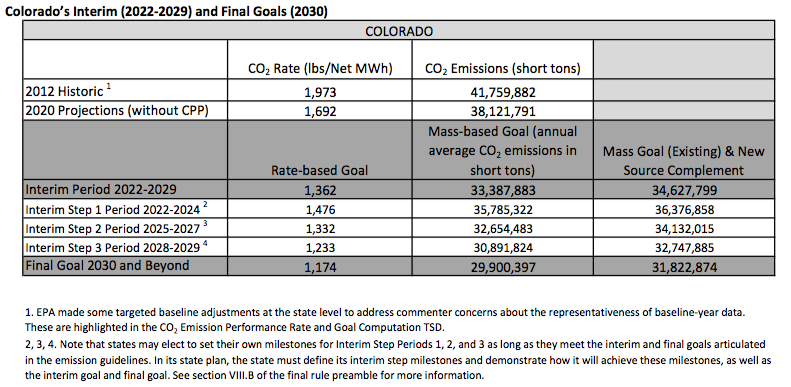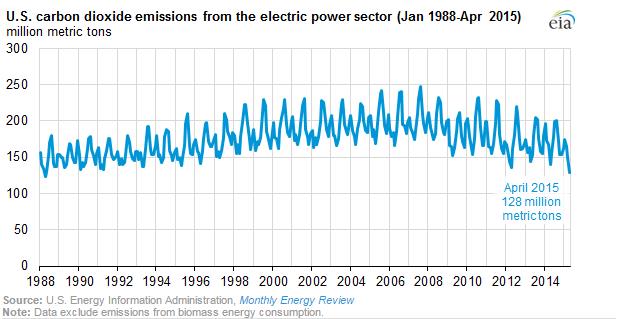Colorado’s expected targets on carbon reduction from the finalized Clean Power Plan unveiled Monday:
Colorado’s 2030 goal of a 28 percent reduction in overall carbon dioxide emissions — or a 40 percent reduction in the pounds of CO2 emitted per megawatt hour of electricity generated — was set using a 2012 benchmark.
“Having them stick to that baseline year of 2012, we don’t necessarily get credit for being early thinkers and early movers,” said Dr. Larry Wolk, executive director and chief medical officer of the Colorado Department of Public Health and Environment.
Colorado’s Attorney General Cynthia Coffman has vowed to review the new rules and could consider joining a multi-state lawsuit against the Clean Power Plan:
Attorney General Cynthia Coffman said the plan “raises significant concerns for Colorado” and that she’s considering joining other states in a legal challenge.
Citing concerns about potential job losses and an unrealistic set of goals and timelines, Coffman said in an e-mail she will ” carefully review the EPA’s plan and evaluate its long term consequences for our state.”
“But as I put the best interests of Colorado first, it may become necessary to join other states in challenging President Obama’s authority under the Clean Air Act.”
It is not clear at this time how long Coffman will take to render a decision on whether or not to join that lawsuit, but the Colorado Department of Public Health and Environment’s Dr. Wolk said that the agency is pushing forward:
“It is the right thing to do,” Wolk said.
If there’s a legal challenge to be had related to EPA authority, that’s a matter specific to the attorney general, he said.
“But it is not something we would use to deter our efforts, which have been underway for several years,” Wolk said.
Governor John Hickenlooper’s office told the Denver Post, “We respect the due diligence of the attorney general in reviewing the plan and will watch the next steps closely.”
Hickenlooper has already made it clear his administration welcomed the Clean Power Plan, and would not join an effort to thwart that plan at the state level.
The final rule moves the deadline for state implementation plans back, and the CDPHE has given an initial nod to allowing the legislature to vote on the agency’s plan:
The final state plan will go to the legislature for approval before submission to the EPA. An initial state plan will be due September 2016 with an option for states to request a two-year extension to September 2018 for submission of the final plan.
How much input the Colorado legislature will have remains to be seen due to the possibility of legislation in 2016 and even 2017. Colorado may file for an extension, giving the legislators additional opportunities to consider enabling legislation, procedural requirements such as a stronger or even mandatory role for the Public Utilities Commission, or other variations on how Colorado submits its CPP SIP. The 2015 session saw SB 258, the Electric Consumers’ Protection Act, pass out of the Senate in bipartisan fashion but ultimately die in Democratically-controlled House. The bill would have sought transparency for the CPP state plan by requiring PUC hearings and deliberation, as well as an up or down vote by the Colorado legislature as a whole.
The Independence Institute published a backgrounder in April, during the rule finalization process, that took a look at possible economic and legal implications of the CPP:
— Will require a new regulatory regime, and holistically seeks to remake the nation’s energy policy;
— Will incur massive costs;
— Will greatly affect energy reliability across the country;
— Is likely illegal; and
–Won’t have any measurable impact on global CO2 emissions.
A quick look at Colorado’s CO2 emission levels from the 2012 baseline show a 40.5 percent reduction in carbon by 2030, from 1973 pounds per megawatt hour down to 1174. Interim goals would reach approximately 31 percent reduction between 2022 and 2029, with states receiving some flexibility on reaching the step reductions. The EPA estimates that by 2020, Colorado would see a 14 percent reduction–without any Clean Power Plan guidelines.
States’ goals fall in a narrower band, reflecting a more consistent approach among sources and states.
At final, all state goals fall in a range between 771 pounds per megawatt-hour (states that have only natural gas plants) to 1,305 pounds per megawatt-hour (states that only have coal/oil plants). A state’s goal is based on how many of each of the two types of plants are in the state.
The goals are much closer together than at proposal. Compared to proposal, the highest (least stringent) goals got tighter, and the lowest (most stringent) goals got looser.
o Colorado’s 2030 goal is 1,174 pounds per megawatt-hour. That’s in the middle of this range, meaning Colorado has one of the moderate state goals, compared to other state goals in the final Clean Power Plan.
o Colorado’s step 1 interim goal of 1,476 pounds per megawatt-hour reflects changes EPA made to provide a smoother glide path and less of a “cliff” at the beginning of the program.
The 2012 baseline for Colorado was adjusted to be more representative, based on information that came in during the comment period.

The full text of the EPA’s outline for Colorado is here:
Colorado Clean Power Plan Goals
***
So why can the EPA project an additional 14 percent reduction of carbon emissions by 2020 without the Clean Power Plan?
Energy In Depth has the details, via the Energy Information Administration:
According to a report released today by the Energy Information Administration (EIA), monthly power sector carbon emissions reached a 27-year low in April of 2015. In that same month, natural gas was, for the first time, the leading source of American electricity. As the EIA puts it:
“The electric power sector emitted 128 million metric tons of carbon dioxide (MMmt CO2) in April 2015, the lowest for any month since April 1988…Comparing April 1988 to April 2015 (27 years), natural gas consumption in the sector more than tripled.” (emphasis added)

EID concludes, “As the EIA’s report clearly shows, these environmental benefits are due in large part to an American abundance of safely produced, clean-burning natural gas.” EPA’s administrator Gina McCarthy has repeatedly pointed to natural gas as a “bridge” or key component in reducing carbon.
But natural gas as a “building block” for CPP compliance is threatened by the next EPA rule to come down the regulatory turnpike, the ground-level ozone rule to be finalized in October, according to the Institute for Energy Research.
***
Studies have considered the cost to the economy and the toll in human terms due to job loss:
President Barack Obama’s plan targeting coal-burning power plants will cost a quarter of a million jobs and shrink the coal industry by nearly half, according to a new report by the American Action Forum (AAF).
The president released final regulations from the Environmental Protection Agency (EPA) on Monday, which require every state to meet strict emission standards for coal-burning power plants in the next 15 years.
The so-called “Clean Power Plan” will cost the industry $8.4 billion, nearly 10 times more expensive than the most burdensome regulation released this year, according to AAF, a center-right think tank led by Douglas Holtz-Eakin, former director of the Congressional Budget Office.
“This week, the Environmental Protection Agency (EPA) released its final greenhouse gas (GHG) standards for existing power plants,” according to the report, authored by AAF’s director of regulatory policy Sam Batkins. “The final plan will shutter 66 power plants and eliminate 125,800 jobs in the coal industry.”
Job loss will be substantial due to the shuttering of coal-fired power plants, including those in Colorado.
It will also likely be heavily localized, as the tenuous situation in northwest Colorado facing the Colowyo Mine and Craig’s coal-fired plant illustrate–and this comes before the state considers how to implement the Clean Power Plan.
Moffat County, where both the mine and power plant reside, would see just a few hundred jobs on the chopping block, but this would devastate the area, as a recent video from Institute for Energy Research showed:
***
Reaction to the rule varied across the spectrum, and the Denver Business Journal gathered a handful of the more pointed statements from both sides:
Joel Serface, managing director of Brightman Energy, a renewable energy development company.
“The Clean Power Plan is a huge opportunity for Colorado’s economy. By tackling the rising economic costs of climate change, we can modernize our energy infrastructure, stimulate innovation and help create thousands of good, new Colorado jobs in high-growth sectors like wind and solar.”
State Sen. John B. Cooke (R-Weld County):
“The Governor needs to commit himself to a true public process, including a rigorous review by the people’s representatives in the Colorado General Assembly, before giving a green light to Colorado’s implementation of this new federal mandate. These rules are being challenged in federal court by sixteen states, and I hope that Colorado’s Attorney General will join that lawsuit now that the EPA rules are final. The fact is, the Clean Air Act passed by Congress does not authorize these costly dictates, and there is a good chance the US Supreme Court will block these rules for that reason.”






